Long-Term Pan-Arctic Evaluation of a Sentinel-1 SAR Sea Ice Extent Product and Insights into Model Integration
Abstract
Highlights
- A pan-Arctic sea ice extent product generated from over 85,000 Sentinel-1 images shows strong agreement with the AMSR2 sea ice concentration product and provides superior capability in depicting the marginal ice zone.
- An Integrated Index is introduced to quantify sub-model contributions in the ensemble used for sea ice extent generation, revealing that three sub-models dominate the results.
- The SAR-based sea ice extent product serves as reliable baseline data for both operational applications and scientific research.
- The Integrated Index offers a methodological basis for optimizing integration strategies, with potential applications in future sea ice ensemble models.
Abstract
1. Introduction
2. Data
2.1. Sentinel-1 Data
2.2. Sentinel-1 SIE Product
2.3. AMSR2 SIC Product
3. Methods
3.1. Workflow of SIE Product Generation
3.2. Matching and SIC Calculation Method
3.3. Evaluation Metric
3.4. Integrated INDEX
4. Results
4.1. Statistical Analysis
4.2. Case Analysis
4.3. Accuracy Validation of Sentinel-1C Products
4.4. Sub-Model Contribution Analysis
5. Discussion
5.1. Applicability and Limitations of 400 m SAR-Derived SIE Products
5.2. Impact of the Sentinel-1 Constellation Degradation on Temporal Variability
5.3. Future Improvements
6. Conclusions
Author Contributions
Funding
Data Availability Statement
Acknowledgments
Conflicts of Interest
References
- Zhou, L.; Zheng, S.; Ding, S.; Xie, C.; Liu, R. Influence of propeller on brash ice loads and pressure fluctuation for a reversing polar ship. Ocean Eng. 2023, 280, 114624. [Google Scholar] [CrossRef]
- Sun, X.; Lv, T.; Sun, Q.; Ding, Z.; Shen, H.; Gao, Y.; He, Y.; Fu, M.; Li, C. Analysis of Spatiotemporal Variations and Influencing Factors of Sea Ice Extent in the Arctic and Antarctic. Remote Sens. 2023, 15, 5563. [Google Scholar] [CrossRef]
- Ivanov, V. Arctic Sea Ice Loss Enhances the Oceanic Contribution to Climate Change. Atmosphere 2023, 14, 409. [Google Scholar] [CrossRef]
- Li, W.; Hsu, C.-Y.; Tedesco, M. Advancing Arctic Sea Ice Remote Sensing with AI and Deep Learning: Opportunities and Challenges. Remote Sens. 2024, 16, 3764. [Google Scholar] [CrossRef]
- Gignac, C.; Bernier, M.; Chokmani, K.; Poulin, J. IceMap250—Automatic 250 m Sea Ice Extent Mapping Using MODIS Data. Remote Sens. 2017, 9, 70. [Google Scholar] [CrossRef]
- Luo, Y.; Liu, Y.; Huang, C.; Han, F. An Ensemble Machine Learning Approach for Sea Ice Monitoring Using CFOSAT/SCAT Data. Remote Sens. 2024, 16, 3148. [Google Scholar] [CrossRef]
- Lu, J.; Scarlat, R.; Heygster, G.; Spreen, G. Reducing Weather Influences on an 89 GHz Sea Ice Concentration Algorithm in the Arctic Using Retrievals from an Optimal Estimation Method. J. Geophys. Res. Ocean. 2022, 127, e2019JC015912. [Google Scholar] [CrossRef]
- Hao, H.; Su, J.; Shi, Q.; Li, L. Arctic sea ice concentration retrieval using the DT-ASI algorithm based on FY-3B/MWRI data. Acta Oceanol. Sin. 2021, 40, 176–188. [Google Scholar] [CrossRef]
- Li, M.; Liu, J.; Qu, M.; Zhang, Z.; Liang, X. An Analysis of Arctic Sea Ice Leads Retrieved from AMSR-E/AMSR2. Remote Sens. 2022, 14, 969. [Google Scholar] [CrossRef]
- Karvonen, J. Baltic Sea Ice Concentration Estimation from C-Band Dual-Polarized SAR Imagery by Image Segmentation and Convolutional Neural Networks. IEEE Trans. Geosci. Remote Sens. 2022, 60, 1–11. [Google Scholar] [CrossRef]
- Matthews, J.L.; Peng, G.; Meier, W.N.; Brown, O. Sensitivity of Arctic Sea Ice Extent to Sea Ice Concentration Threshold Choice and Its Implication to Ice Coverage Decadal Trends and Statistical Projections. Remote Sens. 2020, 12, 807. [Google Scholar] [CrossRef]
- Rusin, J.; Lavergne, T.; Doulgeris, A.P.; Scott, K.A. Resolution enhanced sea ice concentration: A new algorithm applied to AMSR2 microwave radiometry data. Ann. Glaciol. 2025, 65, e15. [Google Scholar] [CrossRef]
- Chi, J.; Kim, H.-C.; Lee, S.; Crawford, M.M. Deep learning based retrieval algorithm for Arctic sea ice concentration from AMSR2 passive microwave and MODIS optical data. Remote Sens. Environ. 2019, 231, 111204. [Google Scholar] [CrossRef]
- Spreen, G.; Kaleschke, L.; Heygster, G. Sea Ice Remote Sensing Using AMSR-E 89-GHz Channels. J. Geophys. Res. Ocean 2008, 113, C02S03. [Google Scholar] [CrossRef]
- Dworak, R.; Liu, Y.; Key, J.; Meier, W.N. A Blended Sea Ice Concentration Product from AMSR2 and VIIRS. Remote Sens. 2021, 13, 2982. [Google Scholar] [CrossRef]
- Lohse, J.; Doulgeris, A.P.; Dierking, W. Mapping Sea-Ice Types from Sentinel-1 Considering the Surface-Type Dependent Effect of Incidence Angle. Ann. Glaciol. 2020, 61, 260–270. [Google Scholar] [CrossRef]
- Yan, C.; Fan, X.; Fan, J.; Wang, N. Improved U-Net Remote Sensing Classification Algorithm Based on Multi-Feature Fusion Perception. Remote Sens. 2022, 14, 1118. [Google Scholar] [CrossRef]
- Jiang, D.; Li, X.; Zhang, K.; Marinsek, S.; Hong, W.; Wu, Y. Automatic Supraglacial Lake Extraction in Greenland Using Sentinel-1 SAR Images and Attention-Based U-Net. Remote Sens. 2022, 14, 4998. [Google Scholar] [CrossRef]
- Shaar, F.; Yılmaz, A.; Topcu, A.E.; Alzoubi, Y.I. Remote Sensing Image Segmentation for Aircraft Recognition Using U-Net as Deep Learning Architecture. Appl. Sci. 2024, 14, 2639. [Google Scholar] [CrossRef]
- Chang, L.; Chen, Y.-T.; Wu, M.-C.; Alkhaleefah, M.; Chang, Y.-L. U-Net for Taiwan Shoreline Detection from SAR Images. Remote Sens. 2022, 14, 5135. [Google Scholar] [CrossRef]
- Ronneberger, O.; Fischer, P.; Brox, T. U-net: Convolutional networks for biomedical image segmentation. In Proceedings of the Medical Image Computing and Computer-Assisted Intervention—MICCAI 2015: 18th International Conference, Munich, Germany, 5–9 October 2015; Proceedings, Part III 18. Springer: Berlin/Heidelberg, Germany, 2015; pp. 234–241. [Google Scholar]
- Wang, Y.-R.; Li, X.-M. Arctic Sea Ice Cover Data from Spaceborne Synthetic Aperture Radar by Deep Learning. Earth Syst. Sci. Data 2021, 13, 2723–2742. [Google Scholar] [CrossRef]
- Melsheimer, C. ASI Version 5 Sea Ice Concentration User Guide; Version V0.9.4 (9 August 2024); Institute of Environmental Physics, University of Bremen: Bremen, Germany, 2024; Available online: https://seaice.uni-bremen.de/fileadmin/user_upload/ASIuserguide.pdf (accessed on 15 July 2025).
- Sun, Y.; Li, X.-M. Denoising Sentinel-1 Extra-Wide Mode Cross-Polarization Images Over Sea Ice. IEEE Trans. Geosci. Remote Sens. 2021, 59, 2116–2131. [Google Scholar] [CrossRef]
- Murashkin, D.; Spreen, G.; Huntemann, M.; Dierking, W. Method for Detection of Leads from Sentinel-1 SAR Images. Ann. Glaciol. 2018, 59, 124–136. [Google Scholar] [CrossRef]
- Dimitrovski, I.; Spasev, V.; Loshkovska, S.; Kitanovski, I. U-Net Ensemble for Enhanced Semantic Segmentation in Remote Sensing Imagery. Remote Sens. 2024, 16, 2077. [Google Scholar] [CrossRef]
- Du, K.-L.; Zhang, R.; Jiang, B.; Zeng, J.; Lu, J. Foundations and Innovations in Data Fusion and Ensemble Learning for Effective Consensus. Mathematics 2025, 13, 587. [Google Scholar] [CrossRef]
- Chen, Z.; Ding, Z.; Zhang, X.; Zhang, X.; Qin, T. Improving Out-of-Distribution Generalization in SAR Image Scene Classification with Limited Training Samples. Remote Sens. 2023, 15, 5761. [Google Scholar] [CrossRef]
- Wang, J.; Wang, H.; Sun, Z. Research on the Effectiveness of Deep Convolutional Neural Network for Electromagnetic Interference Identification Based on I/Q Data. Atmosphere 2022, 13, 1785. [Google Scholar] [CrossRef]
- Ludwig, V.; Spreen, G.; Pedersen, L.T. Evaluation of a New Merged Sea-Ice Concentration Dataset at 1 km Resolution from Thermal Infrared and Passive Microwave Satellite Data in the Arctic. Remote Sens. 2020, 12, 3183. [Google Scholar] [CrossRef]
- Wang, J.; HQ Ding, C.; Chen, S.; He, C.; Luo, B. Semi-Supervised Remote Sensing Image Semantic Segmentation via Consistency Regularization and Average Update of Pseudo-Label. Remote Sens. 2020, 12, 3603. [Google Scholar] [CrossRef]
- Baumhoer, C.A.; Dietz, A.J.; Kneisel, C.; Kuenzer, C. Automated Extraction of Antarctic Glacier and Ice Shelf Fronts from Sentinel-1 Imagery Using Deep Learning. Remote Sens. 2019, 11, 2529. [Google Scholar] [CrossRef]
- Zollini, S.; Dominici, D.; Alicandro, M.; Cuevas-González, M.; Angelats, E.; Ribas, F.; Simarro, G. New Methodology for Shoreline Extraction Using Optical and Radar (SAR) Satellite Imagery. J. Mar. Sci. Eng. 2023, 11, 627. [Google Scholar] [CrossRef]
- Ghaffarian, S.; Valente, J.; van der Voort, M.; Tekinerdogan, B. Effect of Attention Mechanism in Deep Learning-Based Remote Sensing Image Processing: A Systematic Literature Review. Remote Sens. 2021, 13, 2965. [Google Scholar] [CrossRef]
- Wang, G.; Chen, J.; Mo, L.; Wu, P.; Yi, X. Border-Enhanced Triple Attention Mechanism for High-Resolution Remote Sensing Images and Application to Land Cover Classification. Remote Sens. 2024, 16, 2814. [Google Scholar] [CrossRef]
- Chen, P.; Zhou, H.; Li, Y.; Liu, P.; Liu, B. A Novel Deep Learning Network with Deformable Convolution and Attention Mechanisms for Complex Scenes Ship Detection in SAR Images. Remote Sens. 2023, 15, 2589. [Google Scholar]
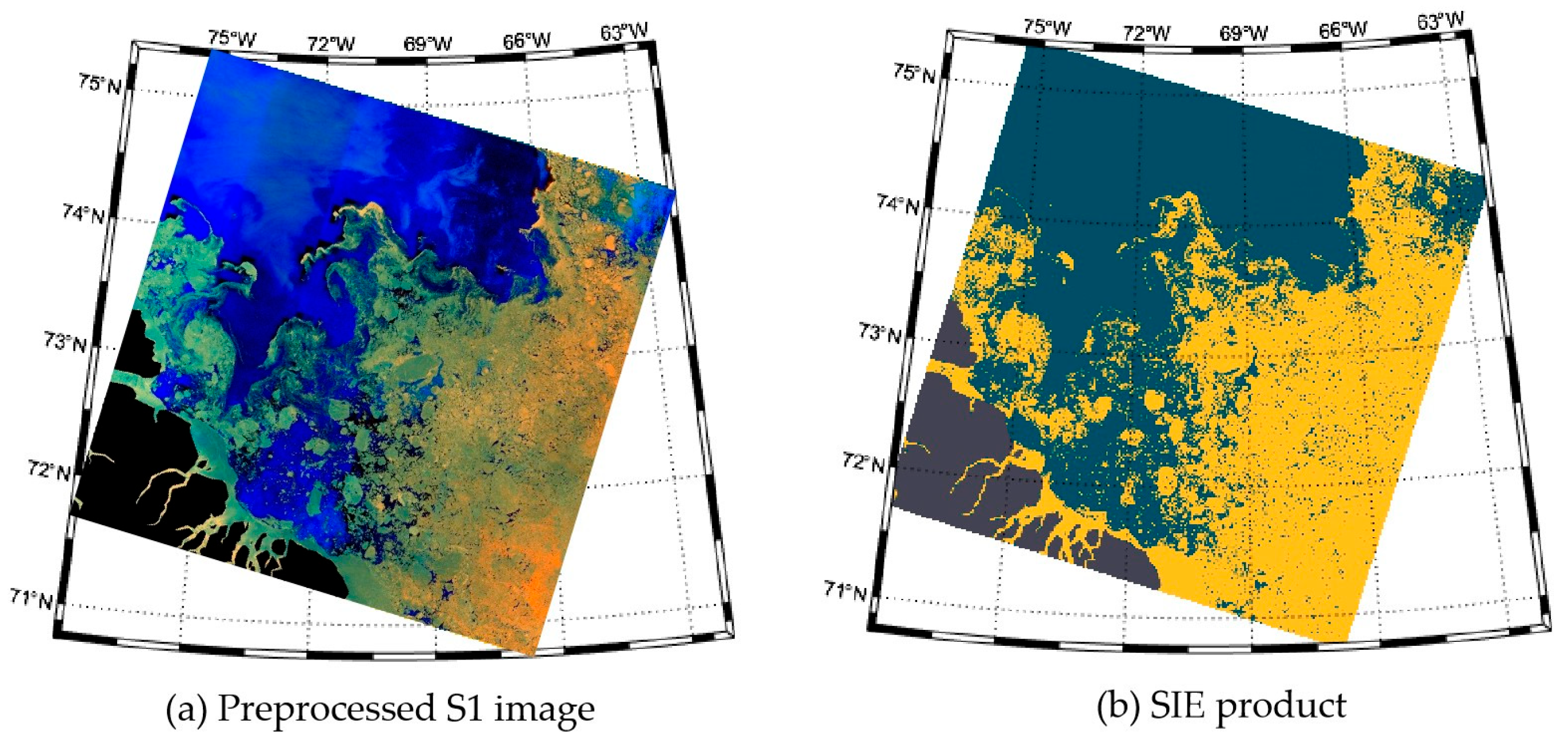

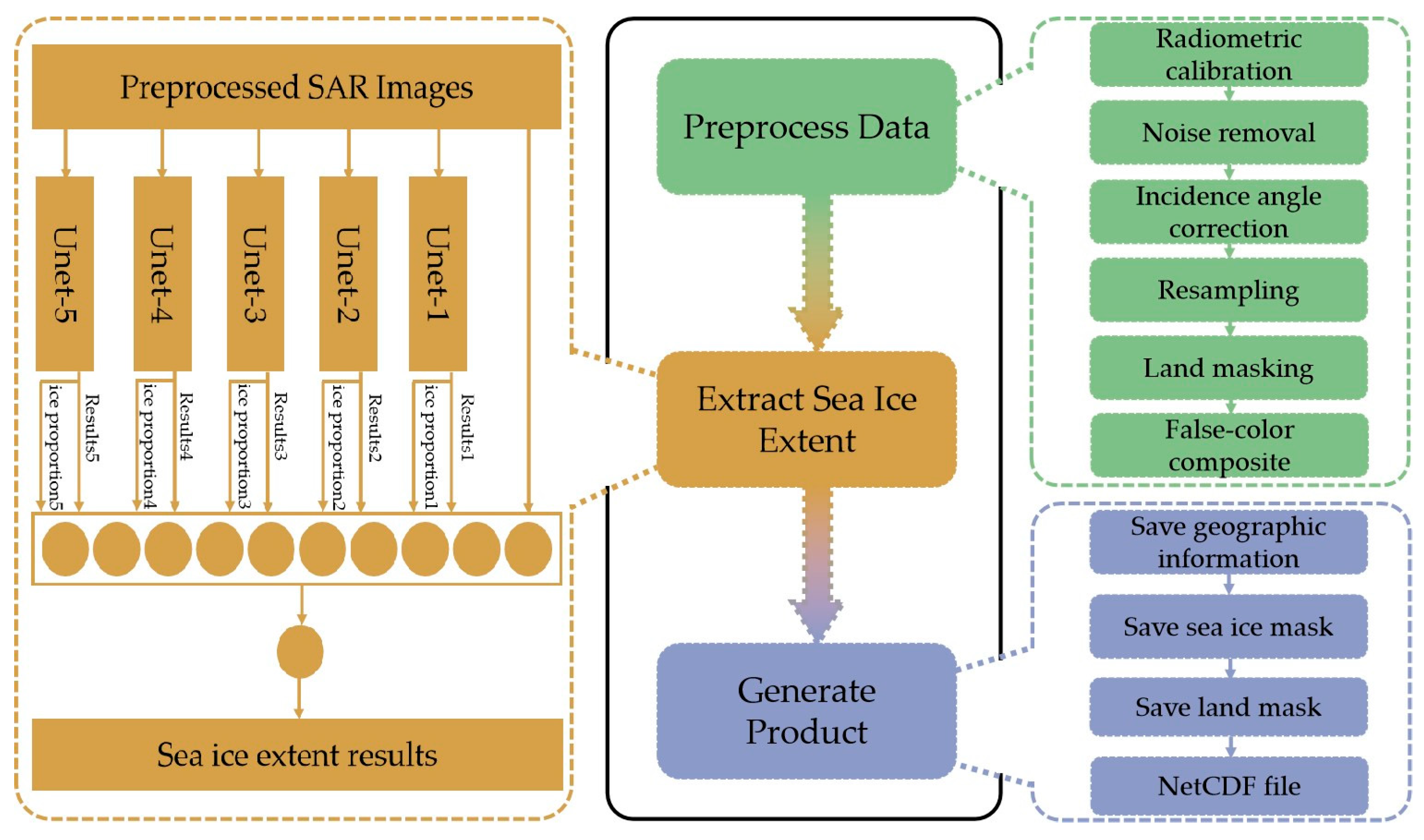
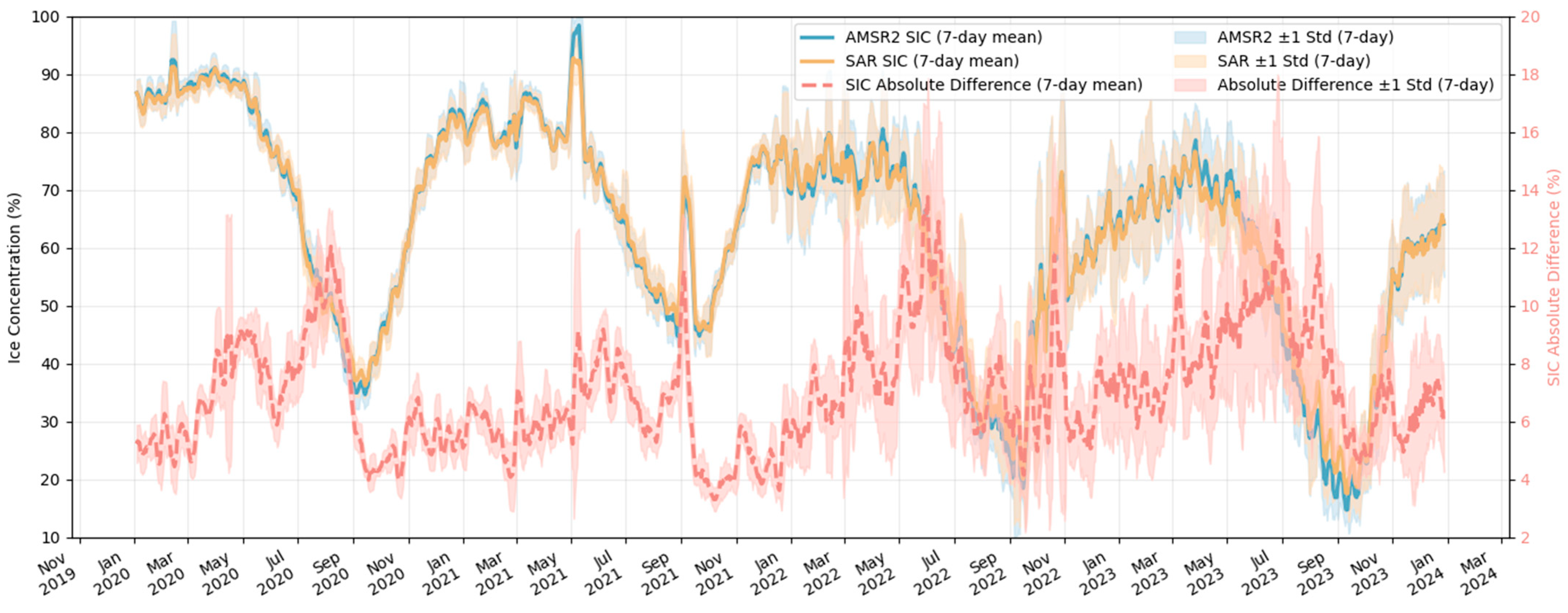
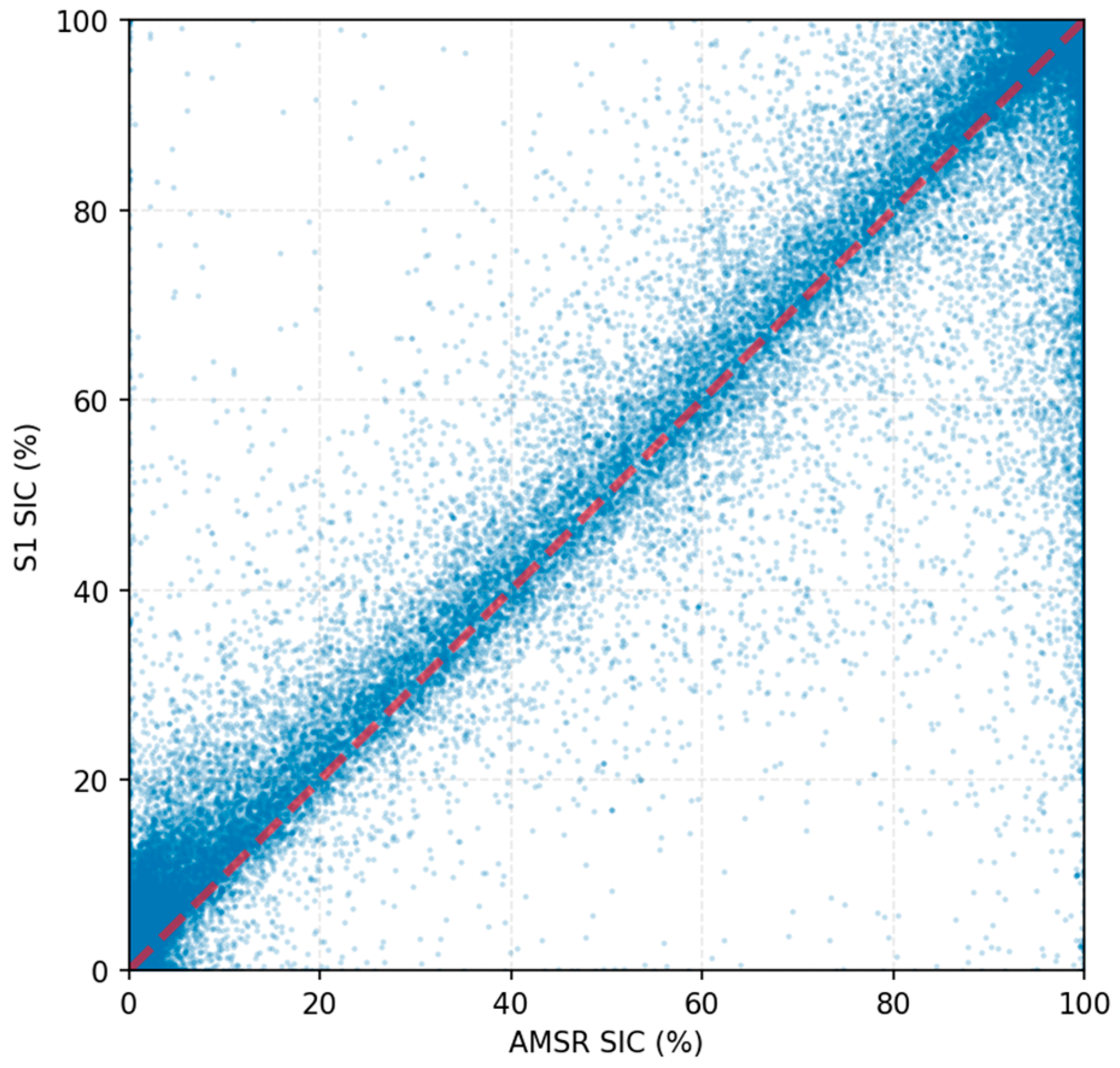





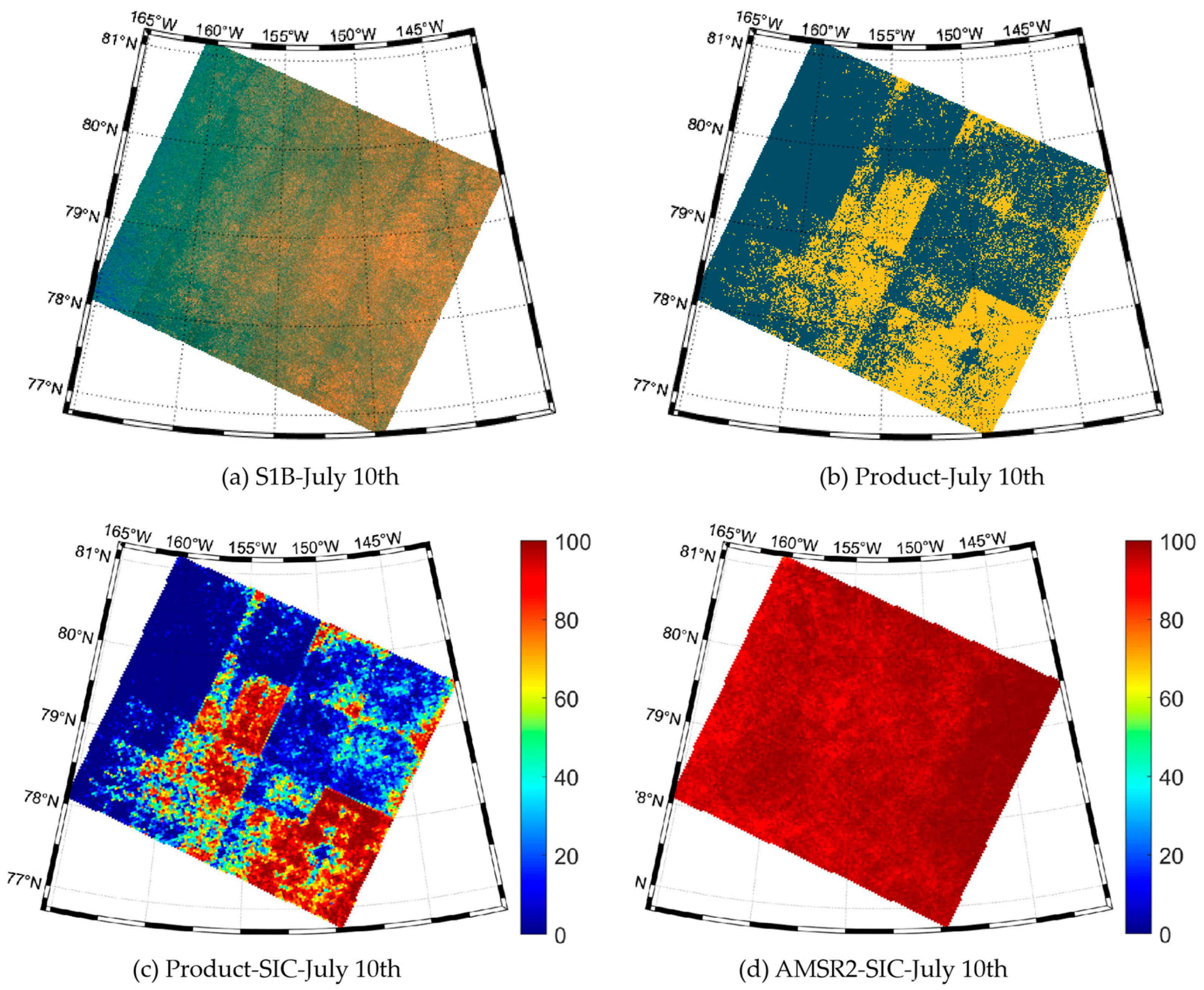
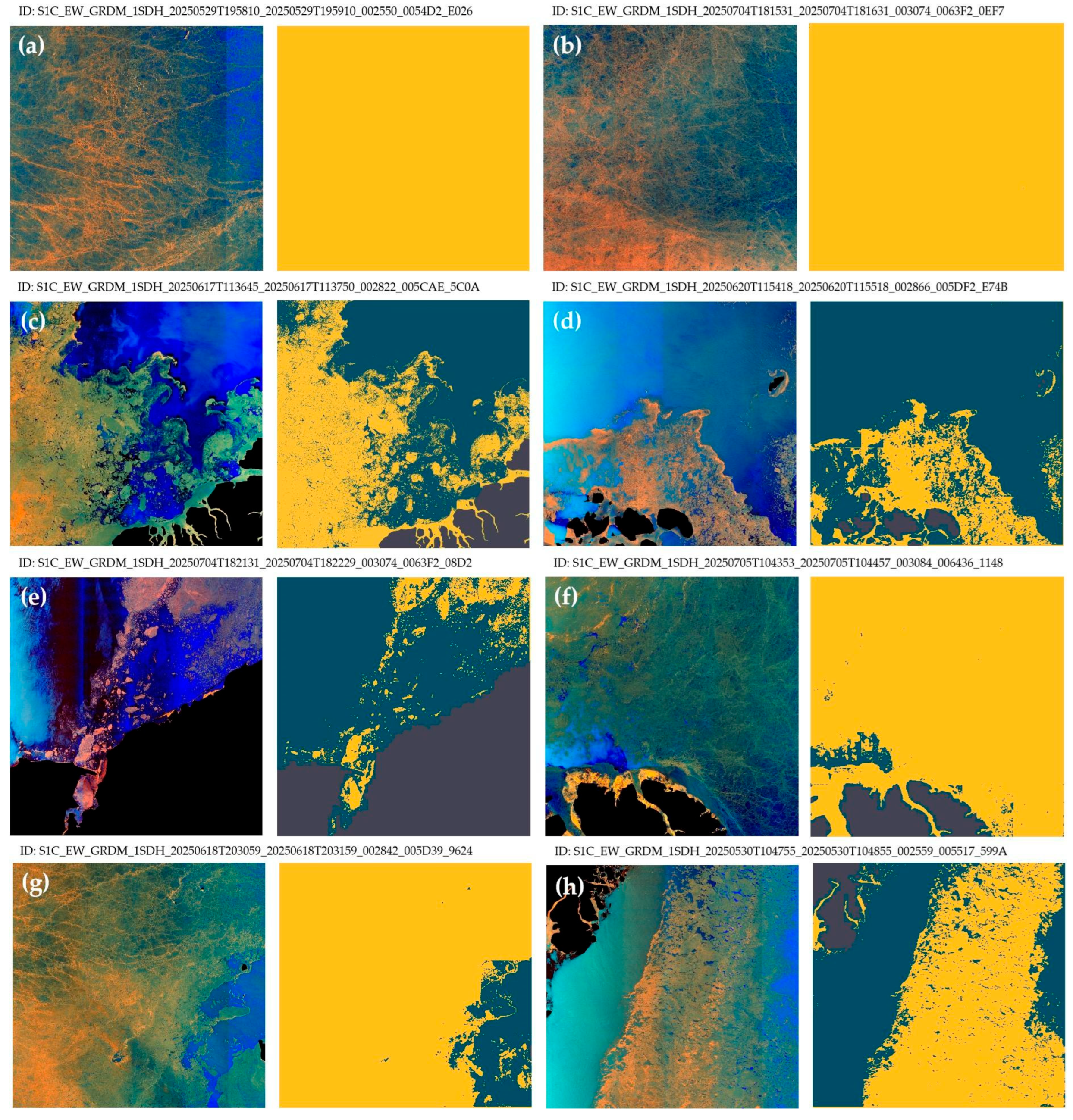
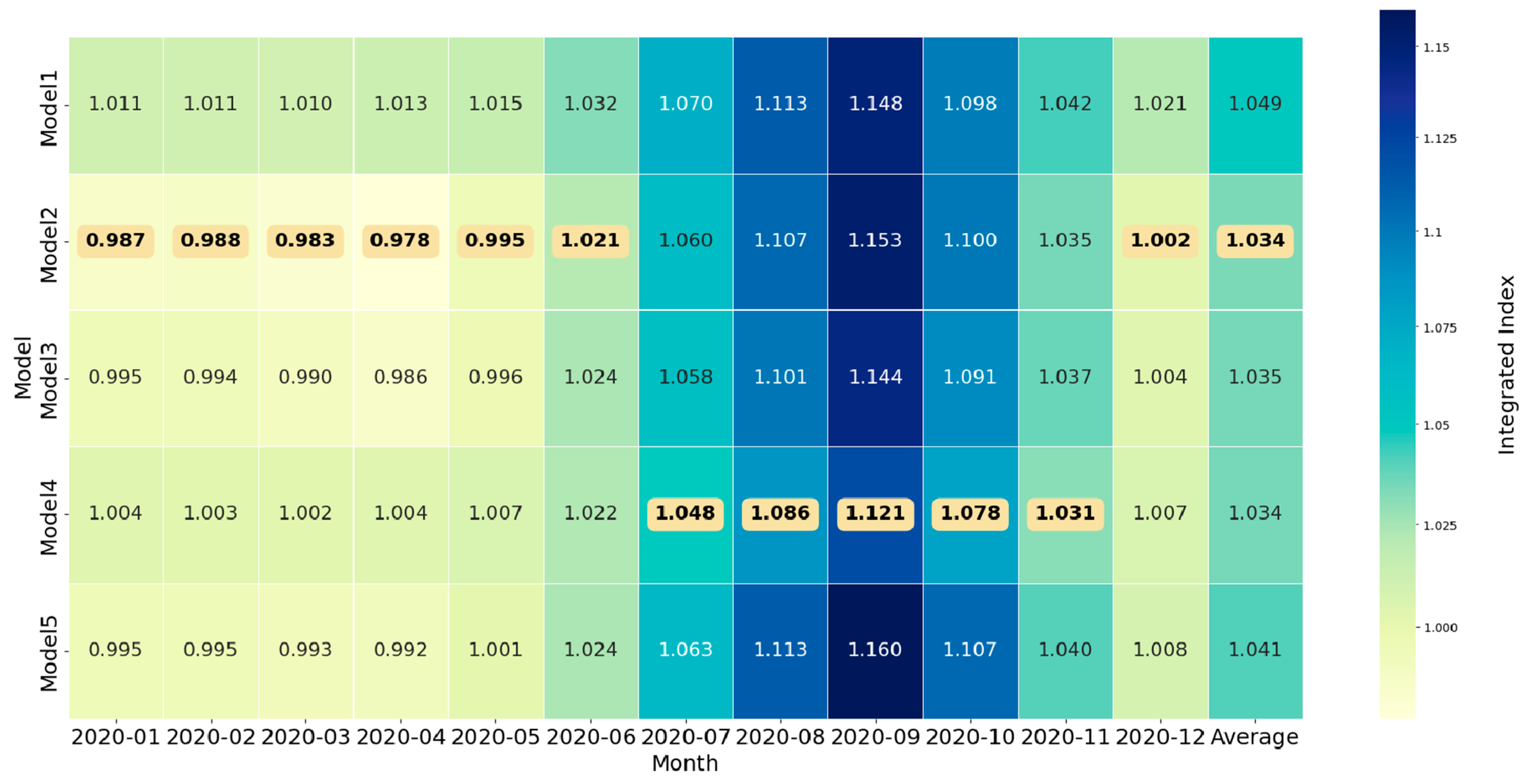


| No. | Variables | Descriptions |
|---|---|---|
| 1 | Longitude | Longitude of each sea ice and land mask record |
| 2 | Latitude | Latitude of each sea ice and land mask record |
| 3 | SeaIce | 0 denotes open water, and 1 denotes sea ice |
| 4 | Mask | 0 indicates no land, and 1 indicates land |
Disclaimer/Publisher’s Note: The statements, opinions and data contained in all publications are solely those of the individual author(s) and contributor(s) and not of MDPI and/or the editor(s). MDPI and/or the editor(s) disclaim responsibility for any injury to people or property resulting from any ideas, methods, instructions or products referred to in the content. |
© 2025 by the authors. Licensee MDPI, Basel, Switzerland. This article is an open access article distributed under the terms and conditions of the Creative Commons Attribution (CC BY) license (https://creativecommons.org/licenses/by/4.0/).
Share and Cite
Yuan, H.; Guo, Q.; Ren, Y.; Fu, H.; Li, X.-M. Long-Term Pan-Arctic Evaluation of a Sentinel-1 SAR Sea Ice Extent Product and Insights into Model Integration. Remote Sens. 2025, 17, 3166. https://doi.org/10.3390/rs17183166
Yuan H, Guo Q, Ren Y, Fu H, Li X-M. Long-Term Pan-Arctic Evaluation of a Sentinel-1 SAR Sea Ice Extent Product and Insights into Model Integration. Remote Sensing. 2025; 17(18):3166. https://doi.org/10.3390/rs17183166
Chicago/Turabian StyleYuan, Haotian, Qing Guo, Yongzheng Ren, Han Fu, and Xiao-Ming Li. 2025. "Long-Term Pan-Arctic Evaluation of a Sentinel-1 SAR Sea Ice Extent Product and Insights into Model Integration" Remote Sensing 17, no. 18: 3166. https://doi.org/10.3390/rs17183166
APA StyleYuan, H., Guo, Q., Ren, Y., Fu, H., & Li, X.-M. (2025). Long-Term Pan-Arctic Evaluation of a Sentinel-1 SAR Sea Ice Extent Product and Insights into Model Integration. Remote Sensing, 17(18), 3166. https://doi.org/10.3390/rs17183166







